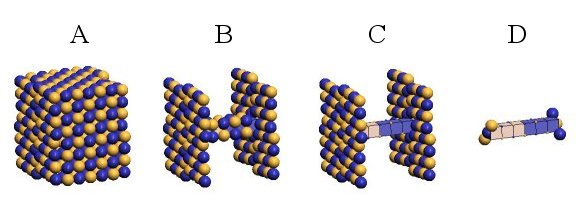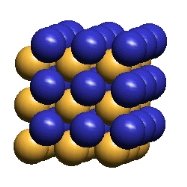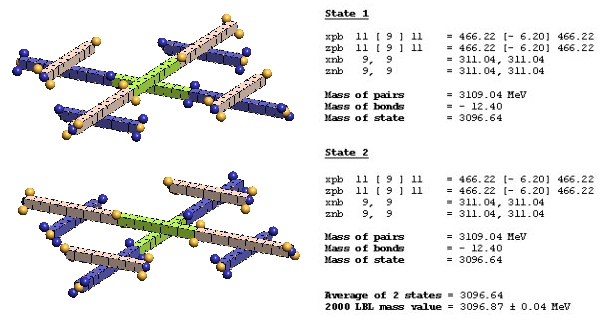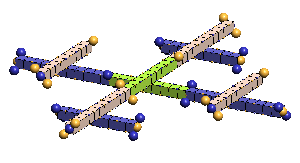INTRODUCTION
Section 3
Other Important Concepts Of IPP
Properties of Elemental Charge Entities
IPP considers space to be solidly filled with Elemental Charge Entities (hereafter, ECEs). ECEs are visualized as solid spherical particles, whose diameters* are very close to 0.2 fm (0.2 x 10–15 m), and whose charges** are +1/2e, or –1/2e, both charges being equally abundant in the universe. ECEs are assumed to be something like chemical ions, like-polarity repelling, opposite-polarity attracting, and not capable of annihilating, even in intimate contact with each other.
* The three orthogonal defect-pairs of IPP's proton have an average defect spacing of about 9 lattice units, which gives it a charge radius of 4.5 ECE diameters. Comparing this with the measured root-mean-square charge radius of the proton (0. 84 ± 0.02 fm) yields the suggested figure. (I obtained this value from Yu A. Alexandrov,"Fundamental Properties of the Neutron", [Clerendon Press - Oxford 1992], p. 125).
** IPP discerns this charge value for an ECE by identifying the electron as a "lattice replacement defect". See Section Four for clarification of this point.
IPP postulates that ECEs are present in such abundance that opposite-polarity ECEs have been brought into contact throughout the universe, and in such excess that regions of space cannot assume a regular (perfect) simple cubic lattice form, but will everywhere exhibit various degrees of rhombic distortion. This excess of ECEs assures that space is polycrystalline, and full of lattice defects (the central feature of IPP infinite particles) and lattice-density oscillations (the phenomenon that IPP identifies with photons, mass-energy, particle movement, forces, etc.).
Origin of Universe in IPP Theory
This super-abundance of ECEs rules out* a big bang origin of the universe, but IPP offers an alternative creation scenario, in which pairs of opposite-polarity ECEs are continuously injected into the center of all galaxies.
* If you currently favor the big bang, I commend to you a very persuasive book, "BYE BYE BIG BANG, Hello Reality", by William C. Mitchell (Cosmic Sense Books, P.O. Box 3472, Carson City, Nevada 89702, U.S.A.). He argues that there is abundant observational evidence that the universe is orders of magnitude older than what big bang proponents assert, and suggests, as an alternative, a recycling universe cosmology, in which new galaxies are continually being created (to replace dying galaxies) out of the matter and energy that living galaxies continuously emit into empty space over their life spans. IPP's explanation for the creation of hydrogen atoms in "empty" space (above, in Section 2) supports his contention.
I argue that this ECE injection process can, over time, result in a non-expanding universe that exhibits both redshift and cosmic background microwave radiation. Here's why:
Here's why redshift occurs: A photon, in IPP, is a point-centered ellipsoidal oscillation in the packing density of ECEs in the space lattice, whose recurring zones of central compaction step through the lattice at the speed of light. A photon can transfer a portion of its total mass-energy when its (stepping) center of compaction happens to coincide precisely with the center of oscillation of a void-pair (IPP's concept of an electron neutrino). This coincidence results in some of the photon's energy being used to ionize (separate) the void-pair into two opposite-polarity lone voids (IPP's concepts of muon neutrinos & muon antineutrinos), so the photon leaves the interaction site red-shifted.
The photon's trajectory is not deflected by the interaction, because opposite-polarity voids have identical rest masses. In separating, the two voids (each of which has higher mass-energy than a void-pair) acquire too much momentum to recombine immediately, and simply join the myriads of energetic voids & void-pairs circulating throughout the cosmos.
Notice that IPP's redshift scenario has the potential for explaining a current mystery, deficiency of detected electron neutrinos emitted from our sun. Here's the problem: The scientists in charge of the various subterranean neutrino detectors have all concluded that the flux of electron neutrinos striking earth is substantially less than the amount predicted by astrophysical calculations of solar processes.
Here's IPP's interpretation: Although in the general redshift case, I have assumed that the intersected void-pair has very low absolute momentum, we should perceive that, if the interacting photon emerges from the same source, and in the same direction as the void-pair, the two particles will be able to interact even if the void-pair is moving at virtually the speed of light. In fact, the probability of interaction is much higher, because the photon and void-pair linger together for a much longer time!
Notice, also, that this scenario of void-pair deficiency may be capable of explaining the extreme redshift of quasars, and hence the false perception of their extreme distance. If we were to assume that their unusual brightness is caused by the annihilation of matter & antimatter, their extreme redshift could be accounted for by the copious quantities of electron neutrinos (void-pairs) that hadron annihilations produce.
Here's what creates background microwave radiation: The lone voids released from photon/void-pair interactions, being half-charge particles, can lose (or gain) momentum by interacting with other charged particles. Hence, amongst the myriads of voids in "empty" space, there will always be numerous opposite-polarity voids with sufficiently low momentum to recombine into void-pairs, and each recombination of plus and minus voids neutralizes their charge fields, and, hence, releases the energy bound up in these fields. This released energy divides equally into void-pair momentum and into an oppositely-directed photon, whose energy is plausibly* in the fractionally milli-eV level of CMBR. The randomness of both the locations and the emitted directions of these recombination events nicely accounts for the measured radial uniformity of the cosmic microwave background radiation.
* The extreme strength of an electric field vs. a gravitational field may cast doubt on this plausibility. However, when I discuss forces (in Article 4 of the navigation bar), I will show that the difference in the amount of force exerted by these two types of fields is related to the different nature of the rhombic displacements that these two fields create.
Particles in IPP Theory
IPP considers particles to be ever-growing spheroidal lattice-density oscillations that are distorted by and centered upon defects or clusters of defects. These oscillations expand at superluminal speed* toward infinite size, in a space lattice that is common to all matter.
* It is quite common for readers of my work to balk when I suggest that distortion patterns expand at superluminal speeds. The explanation is quite simple, and does in no way violate Einstein's dictum! All of IPP photons & particles are point-centered infinite distortion patterns that contain in-and-out lattice-density oscillations. Obviously, then, if the centers of these patterns can move through space at the speed of light (photons), or nearly at the speed of light (particles), then these in-and-out oscillatory patterns must be capable of moving faster than the speed of light! What makes all phenomena seem to obey Einstein is that we can't measure the speed of anything except photon & particle centers! This is true, because the only way we can detect the arrival of any phenomenon is through its interactions with some detector, and these interactions occur only when an arriving center coincides with a detector center.
The oscillation binding process starts when a defect cluster is created, because it takes the local lattice agitation of a point-centered oscillation to fracture the lattice sufficient to produce defects. Permanent binding occurs between oscillator and defects through a feedback process, whereby the cluster's charge field induces oscillator drift away from the cluster, while the oscillator's central rotations induce defect rotations (translations) around the oscillator center. It is this binding of lattice-density oscillations to defect clusters that endows IPP's particles with simultaneous wave and particle attributes.
It is easy to perceive why the waveforms of hovering lattice-density oscillations are distorted by the presence of defects at their centers. Any distortion that the presence of defects produces in the space lattice must obviously occur in the same ECEs that its bound oscillator uses. Therefore, the oscillator waveform will be a vector summation of the two influences.
Collapsed-Void Defects
The correlations of specific lattice defects with leptons and hadrons is the subject of Section Four, but a preliminary look at IPP's most significant discovery, the collapsed void defect, may help you to visualize the patterns that defects create in the lattice of space by their presence.
The animated drawings below show the process of collapse & uncollapse of unpaired void defects that find themselves at the center of a vigorous lattice-density oscillation. The crucial thing to notice in the unusual patterns of the ECEs in the collapsed patterns is that they appear to exhibit expansion in two quadrants, and contraction in the other two quadrants. It is this central pattern of expansion/contraction distortion that leads to the pairing of collapsed-voids (hereafter, c-voids), forming structures which IPP terms, defect-pairs. Defect-pairs are the building blocks that cluster together in various numbers and in various internal defect spacings to form IPP's hadron particles. In these drawings, the colors of the spherical balls indicate ECE charges as follows:
| Orange Colored Spheres = +1/2e Charge ECE |
| Blue Colored Spheres = –1/2e Charge ECE |
|
Uncollapsed
(Lower Void Location) |
Collapsed |
Uncollapsed
(Upper Void Location) |
Minus C-Void
Left Slant |
 |
 |
 |
Minus C-Void
Right Slant |
 |
 |
 |
Plus C-Void
Left Slant |
 |
 |
 |
Plus C-Void
Right Slant |
 |
 |
 |
The four rows of figures above show the two possible lattice face-diagonal directions of collapse & uncollapse of both polarities of voids in one of the three cardinal planes of the space lattice. These drawings show the central plane of symmetry of the ever-expanding distortion pattern IPP calls "a hovering collapsed-void (c-void) defect". If you focus on the fully collapsed state of these two patterns, you will notice that each possesses identical face-diagonal zones of both expansion and contraction, but that these zones have opposite orientation in the two patterns. This is very interesting! It suggests that two c-voids of either polarity might join together into a stable structure by mutual cancellation of most of each other's expansion & contraction distortion. But, you will perceive, that this cancellation can occur only if the two c-voids satisfy the following geometrical requirements:
- They site at least a few lattice units away in cardinal directions from each other.
- Their planes of symmetry are parallel to each other.
- Their distortion patterns have opposite orientation.
And what is really interesting is that we can infer that this cancellation process of paired c-voids should function over a wide range of inter-defect spacings, due to the fact that almost all of the mutual cancellation of distortion occurs remote from the two defects, since each pattern has its mass-energy distributed in equal radial increments to infinity!
This conclusion follows directly from correlating mass-energy with rhombic distortion, presuming that we view this distortion as rotational displacements of ECEs from their "empty-space" cubic lattice locations. We know that the displacement amplitude of a spherically-spreading disturbance diminishes as the inverse-square of its radial distance from its center, 1/r², while the volume of these displacements increases as the radius squared, r². Thus, the mass-energy captured by these displacements in any spherical shell of the pattern is proportional to 1/r² x r² = 1.
We should notice that this relationship couldn't hold for a distortion pattern's central region, except for phenomena possessing very small mass-energies. For larger mass-energies, the pattern's center will "saturate", because ECE rotations must cease whenever local ECEs achieve maximum compactness. Central pattern "saturation" has interesting implications for explaining particle creations at annihilation centers, which we explore later in this section, and for explaining defect translocations, defect-pair charge-exchanges, and polarizations in light and particles, which we explore in our Introductory Tutorial.
IPP calls the pattern produced by two paired c-voids a "defect-pair". The animated figure, below, shows four steps of its abstraction (i.e., its progressive simplification) leading to the defect-pair symbol (drawing D) that we use in all the website drawings of hadron particles.

- Drawing A includes all the intervening ECEs between the two 8 x 8 cardinal planes in which the two paired c-voids are centered.
- Drawing B deletes all the intervening ECEs except for a central column of lattice cubes connecting the two c-voids.
- In Drawing C, this column is replaced with a square girder whose nodes are occupied with 1/5 size ECEs that take the place of the full-sized ECEs in the column.
- Finally, in Drawing D, all the ECEs of the two defect planes are deleted except for the three central ECEs that lie in the direction of the axis of expansion of the two paired c-voids.
The four significant aspects of defect-pairs:
Notice that IPP's defect-pair symbol (drawing D) lets you perceive its four significant aspects:
- The cardinal direction in which the two defects are paired (a direction which passes through the center of the square girder connecting the two c-voids)
- The slant direction of the defect-pair (left-slant or right-slant --- defined later in Hadron Tutorial)
- The charges of its two paired c-void defects (this is simply the charge-sum of the three ± 1/2e charge ECEs that remain in the two outside planes)
- The spacing between the paired defects in lattice units (we shall find that these spacings vary from 5 to 15 lattice units in IPP's hadron particles)
Defect-pairs are the building blocks of hadrons and nuclei:
Defect-pairs enable IPP to construct scaled 3-D structures for all known hadrons & nuclei. However, accurately portraying even the center of these patterns is a formidable problem, because there are so many attributes of these dynamic patterns that need explicating. Here are some of the important ones:
- How each paired c-void defect hovers back and forth between two adjacent lattice locations, as the particle's central region repetitively "saturates" and "unsaturates" under the influence of the synchronized* lattice-density oscillation of its component c-voids.
- How face-diagonally related c-voids exchange their charges periodically in a manner that alters the defect-spacings of their respective defect-pairs by ± 1 ü ("ü" is IPP's symbol for a lattice unit).
- How charge-exchanges and particle decays are affected by the slant configurations** (permutations) that the various defect-pairs adopt in the process of clustering together.
- How the c-void defects of a particle move through the space lattice when the particle's hovering oscillator has acquired an ellipsoidal shape that causes its center to "step" through the lattice.
- How these effects are altered when a particle's motion approaches relativistic speed.
* In defect clusters, defects are prevented from manifesting individual hovering oscillations, because these individual oscillators would be completely "frustrated" in trying to establish different frequencies & phases in a group of local ECEs that all must use in common. Clearly, what happens, instead, is that a single hovering oscillation forms, whose frequency is determined by the cluster's total mass-energy, and whose center is at the cluster's center of mass-energy. This reduction of a cluster's wavelength as a function of its captured mass-energy may be the ultimate determinant of how large a nucleus can be and still be stable!
** Perhaps the most interesting example of the relevance of slant permutations is its ability to explain the experimental finding of two distinct decay modes for neutral kaon resonances. It is clear that two orthogonal defect-pairs of 7ü & 9ü defect spacings can associate together in two distinct slant forms, each of which calculates to the correct mass-energy of the neutral kaon, and one can argue persuasively that these different slant geometries should lead to different decay modes. To learn more details about these two structures, see the Hadron Tutorial.
How Particles Can Be Infinite (Forever Expanding)
The concept of infinite particles in IPP derives from its altered concept of particle creation. Rather than being created from energy, IPP suggests that particles are created from space! IPP sees lattice-density oscillations (point-centered oscillatory mass-energy) as the means by which the ECEs of space are rotated and displaced sufficiently to produce defects, or clusters of defects, in the space lattice. In turn, the presence of these defects alters the equilibrium arrangement of ECEs in the cubic space lattice, causing a spherical wave of rhombic displacements to propagate outwardly in an incessantly-expanding fashion.
Why this expanding distortion pattern captures, and maintains constant mass-energy content is clear when one considers that annihilation and creation processes merely exchange infinitely-extending rhombic lattice distortion. Both particle creation and particle decay, from IPP's perspective, are not instantaneous processes, as they are currently perceived, but take place over infinite time. We see, then, that the mass-energy needed by the advancing front of the created particle's expanding distortion pattern is supplied by the retreating collapse of precursor phenomena.
Energy In IPP Theory
IPP views the energy components of mass-energy, as point-centered, unceasingly-expanding oscillations in the packing density of the ECEs in the space lattice, usually referred to as a "lattice-density oscillation". The 3-D shape of these oscillations may vary from spherical to ellipsoidal. A photon, as I stated earlier, is a point-centered ellipsoidal lattice-density oscillation whose center of maximum ECE packing density steps through the space lattice at the speed of light. The point-centered hovering oscillations bound to defects (particles) have ellipticities that vary from spherical to very nearly the same ellipticities as photons. Their centers step through the lattice at speeds that are proportional to the amount of their ellipticity.
You will perceive that IPP's concept of a photon has both particle and wave properties simultaneously! This allows IPP to provide a cogent explanation for the observed two-hole interference effects of a succession of single unaccompanied photons. One sees that, if the photon's center goes through one hole, the photon's oscillatory waves can not only pass through the other hole (without delay), but they can also pass through the metal foil (suffering a propagation delay due to its density). These differing propagation times account for the deflection of the photon's path.
This same explanation applies to particles, too, because a particle's hovering oscillator is also point-centered.
Lattice-density oscillations should be perceived as point-centered, endlessly-expanding lattice distortion patterns that consist of in-and-out-moving spherical shells of compaction and rarefaction whose ECE packing-density fluctuations diminish in inverse-square fashion from their center outwardly. Both the frequency, and the integrated amount of rhombic distortion, of these back & forth lattice oscillations are obviously proportional to the oscillator's captured amount of cosmic mass-energy (i.e., its captured portion of universal rhombic lattice distortion).
The Phenomenon of Oscillator "Saturation"
As the amount of captured mass-energy increases, the central ECE packing-density during the central compaction phase of the oscillator quickly reaches a maximum value, due to the postulated incompressibility of ECEs. IPP calls this condition of maximum central compaction, "saturation". "Saturated" space approaches, but doesn't quite reach, the packing density of a body-centered cubic lattice arrangement of ECEs, which, as you will recall, is IPP's concept of a black hole's internal structure.
"Empty" Space
 |
"Saturated" Space
 |
"Black Hole" Space
 |
When we try to visualize these saturated central patterns, we find a curious conflict, whose implications we must try to understand. As the oscillator's captured mass-energy increases, the radius of the central saturated zone must obviously increase (to capture more mass-energy), yet the radial distance between successive zones of compaction and rarefaction must just as obviously diminish (as befits the inverse relationship between mass-energy and wavelength)!
It seems clear, therefore, that our perception of the way an oscillator pattern changes with increasing captured mass-energy must include two contradictory notions:
- Increasing size of its spherical central saturated zone
- Progressive partitioning of this saturated zone into an increasing number of narrower spherical shells of alternating "saturated" compaction and rarefaction. (The degree of rarefaction of these shells is a puzzle! Their ECE packing density may be even less than "empty" space.)
We explore this paradox in considerable detail in our "Introductory Tutorial".
Particle Creation from IPP's Perspective
How oscillatory rhombic distortion fractures space to create particles: Let's try to picture, from IPP's perspective, a 1550 MeV electron colliding head-on with a 1550 MeV positron, their combined energy being just sufficient to produce a J/psi meson, a transient, perfectly symmetrical, planar, neutral, eight-defect-pair structure, comprised of eight half-charge plus c-voids & eight half-charge minus c-voids. Here are some data on this particle, along with IPP's symbolic representation of these defect-pairs and IPP's calculation of their mass-energy and their internal bond mass-deficits:
J/Psi Charge-Exchange Breakdown

J/Psi Charge-Exchange Animation (States 1 & 2 Alternating)

Here are some aspects of this creation scenario, as IPP views it:
IPP's Concept Of Fields & Forces
The infinite particle approach yields greatly enhanced understanding of the nature of fields and forces. The in-and-out oscillatory waveforms of a particle's hovering oscillation incur differential reflections when the space surrounding it possesses radial variations in the amount & types of rhombic lattice distortion (IPP's concept of fields). These differential reflections serve to change (IPP's concept of forces) the amount of ellipticity of the oscillator's waveform, thereby altering the rate of drift of the oscillator's center and the rate of translation through the lattice of the particle's defects to which the oscillator is bound. The details of these processes are much too complex for this Introduction, so I have elected to place them in a separate tutorial, titled "Fields & Forces", available on the navigation bar to your left.
Introduction - Section 4: "The Lattice Defects Of IPP's Particles"
You can also navigate this article using the navigation bar above.

















